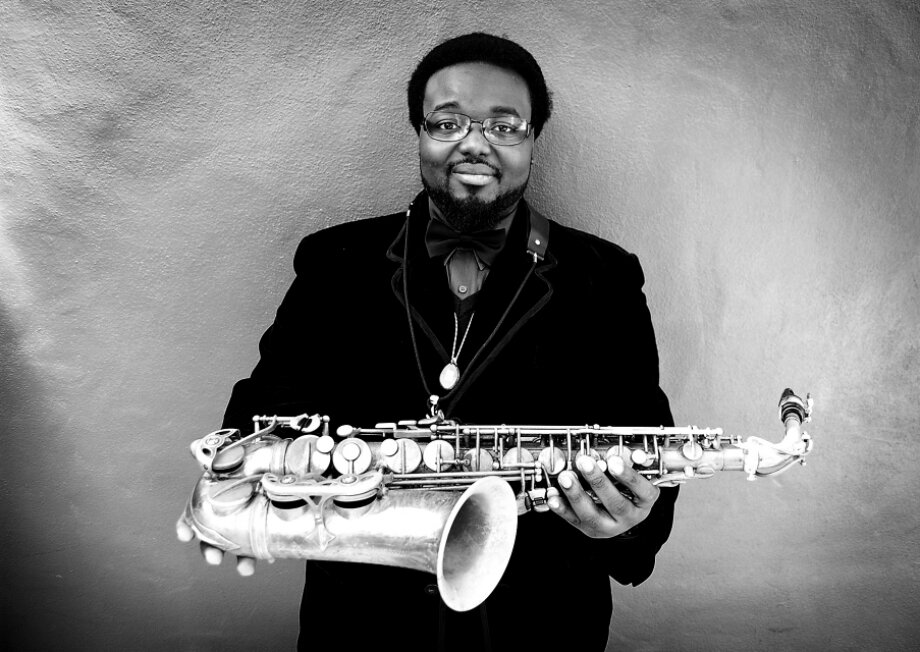The Jazz Gallery 2013-14 Residency Commissions: Godwin Louis Speaks
 This Friday and Saturday, June 20th and 21st, 2014, saxophonist Godwin Louis will present a new musical project at The Jazz Gallery as part of our 2013-2014 Residency Commissions series, which this year features saxophonists and reed players. This is the third performance in the series, following Ben Wendel in February and Greg Ward in May, and will be followed by Ben van Gelder in late June and conclude with Roman Filiu in July.Godwin spent his youth both in Bridgeport, Connecticut, and Port au Prince, Haiti, before studying at the Berklee College of Music and the Thelonious Monk Institute for Jazz. His project draws from his Haitian heritage and his modern jazz training alike. This past week, Godwin spoke to us about the inspiration for his project:
This Friday and Saturday, June 20th and 21st, 2014, saxophonist Godwin Louis will present a new musical project at The Jazz Gallery as part of our 2013-2014 Residency Commissions series, which this year features saxophonists and reed players. This is the third performance in the series, following Ben Wendel in February and Greg Ward in May, and will be followed by Ben van Gelder in late June and conclude with Roman Filiu in July.Godwin spent his youth both in Bridgeport, Connecticut, and Port au Prince, Haiti, before studying at the Berklee College of Music and the Thelonious Monk Institute for Jazz. His project draws from his Haitian heritage and his modern jazz training alike. This past week, Godwin spoke to us about the inspiration for his project:
I attended the Thelonious Monk Institute in New Orleans, where I got to study with the likes of Barry Harris, Jimmy Heath, and Billy Pierce. I’m also of Haitian descent: my parents are from the beautiful island of Haiti, and I actually got to live there between 1994 and 1997. When I moved to New Orleans, the very first thing I noticed was that there was a heavy presence of Catholicism like you’d find in the rest of the Caribbean, whether Antigua, Haiti, the Dominican Republic, or Puerto Rico. I lived next to a Catholic church, and the bell would go off by the hour, which reminded me of Haiti. The cuisine and the architecture were similar, too. Even though I had never studied traditional New Orleans jazz before, when I heard the music, it felt like some of the Haitian music my dad would play for me growing up; there were similar arpeggios and chord movements and cadences. When I was at the Institute, the Lincoln Center Jazz Orchestra did a project in New Orleans. The clarinetist Victor Goines talked about the history of music in New Orleans and the relationship between the city and Haiti. Many Africans that ended up in New Orleans came by way of Haiti, and a big reason for the Louisiana Purchase from Napoleon was the Haitian Revolution. After hearing that, I was like, “Okay. I get it now.” I understood why people called New Orleans the northernmost city in the Caribbean. Also, I got to work with Dr. Michael White, a great New Orleans clarinetist, and he taught me more about how some parts of New Orleans jazz came from Haitian sources. After that, I became more and more interested in Haitian culture, something I took for granted as a teenager. For the past four years, I’ve gone back to Haiti a few times a year to learn more of the country’s history, to try to find documentation supporting the idea that a lot of music passed from Haiti to New Orleans, and to become more familiar with the rhythms of Haitian music. I also began to work on a series of compositions showcasing the connections between Haiti and New Orleans. However, the project has changed over the past few years. A lot of what I’m writing is coming from the rhythms I’ve learned in Haiti and the Haitian composers that I’ve checked out, like Ludovic Lamothe, who was known as the “Black Chopin.” I will be performing some interpretations of his work at The Jazz Gallery as well as my own pieces that try to bring the modern saxophone side of my personality to the Haitian rhythms that I love. There are so many wonderful musical cultures on the continent that travel all over and inform each other, and I feel that it’s very important to draw from them. This is an ongoing project, and I hope to keep adding to it over the next few years.
Godwin Louis will present his new Haitian-inspired musical project this Friday and Saturday, June 20th and 21st, 2014. Louis will appear as part of The Jazz Gallery 2013-14 Residency Commissions. Joining him will be Pauline Jean on vocals, Axel Tosca Laugart on piano, Billy Buss on trumpet, Zach Brown on bass, Nick Falk on drums, and Paulo Stagnaro on percussion. Sets are at 9 and 11 p.m. $22 general admission and $10 for Members. Purchase tickets here. The Jazz Gallery’s Residency Commission 2013-2014 is supported in part by a funding from the Jerome Foundation with additional support from the New York State Council on the Arts and Department of Cultural Affairs of New York City.